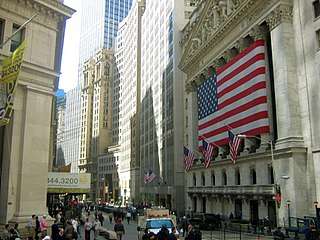Market capitalization
Market capitalization, commonly called market cap, is the market value of a publicly traded company's outstanding shares.

Market capitalization is equal to the share price multiplied by the number of shares outstanding.[2][3] Since outstanding stock is bought and sold in public markets, capitalization could be used as an indicator of public opinion of a company's net worth and is a determining factor in some forms of stock valuation.
Market cap reflects only the equity value of a company. A firm's choice of capital structure has a significant impact on how the total value of a company is allocated between equity and debt. A more comprehensive measure is enterprise value (EV), which gives effect to outstanding debt, preferred stock, and other factors. For insurance firms, a value called the embedded value (EV) has been used.
Market capitalization is used by the investment community in ranking the size of companies, as opposed to sales or total asset figures. It is also used in ranking the relative size of stock exchanges, being a measure of the sum of the market capitalizations of all companies listed on each stock exchange. In performing such rankings, the market capitalizations are calculated at some significant date, such as June 30 or December 31.
The total capitalization of stock markets or economic regions may be compared with other economic indicators. The total market capitalization of all publicly traded companies in the world was US$51.2 trillion in January 2007[4] and rose as high as US$57.5 trillion in May 2008[5] before dropping below US$50 trillion in August 2008 and slightly above US$40 trillion in September 2008.[5] In 2014 and 2015, global market capitalization was US$68 trillion and US$67 trillion, respectively.[6]
Calculation
Market cap is given by the formula , where MC is the market capitalization, N is the number of shares outstanding, and P is the closing price per share.
For example, if a company has 4 million shares outstanding and the closing price per share is $20, its market capitalization is then $80 million. If the closing price per share rises to $21, the market cap becomes $84 million. If it drops to $19 per share, the market cap falls to $76 million. This is in contrast to mercantile pricing where purchase price, average price and sale price may differ due to transaction costs.
Not all of the outstanding shares trade on the open market. The number of shares trading on the open market is called the float. It is equal to or less than N because N includes shares that are restricted from trading. The free-float market cap uses just the floating number of shares in the calculation, generally resulting in a smaller number.
Market cap terms
Traditionally, companies were divided into large-cap, mid-cap, and small-cap.[2] The terms mega-cap and micro-cap have also since come into common use,[7][8] and nano-cap is sometimes heard. Different numbers are used by different indexes;[9] there is no official definition of, or full consensus agreement about, the exact cutoff values. The cutoffs may be defined as percentiles rather than in nominal dollars. The definitions expressed in nominal dollars need to be adjusted over decades due to inflation, population change, and overall market valuation (for example, $1 billion was a large market cap in 1950, but it is not very large now), and market caps are likely to be different country to country.
See also
- List of public corporations by market capitalization
- List of finance topics
- List of stock exchanges
- London Stock Exchange
- Market price
- Market trend
- Middle-market company
- NASDAQ
- New York Stock Exchange
- Public float
- Shares authorized
- Treasury stock
References
- "Market highlights for first half-year 2010" (PDF). World Federation of Exchanges. Archived from the original (PDF) on July 22, 2013. Retrieved May 29, 2013.
- "Market Capitalization Definition". Retrieved April 2, 2013.
- "Financial Times Lexicon". Archived from the original on September 25, 2016. Retrieved February 19, 2013.
- Global stock values top $50 trln: industry data (Reuters)
- WFE Report Generator including report for Domestic Market Capitalization 2008 Archived October 8, 2008, at the Wayback Machine (World Federation of Exchanges)
- WFE Full Year Statistics 2015 (World Federation of Exchanges)
- "Mega Cap Definition". Retrieved April 2, 2013.
- "Micro Cap Definition". Retrieved April 2, 2013.
- Definition of Market Capitalization
External links
| Look up market capitalization in Wiktionary, the free dictionary. |
- How to Value Assets – from the Washington State (U.S.) government web site
- Year-end market capitalization by country – World Bank, 1988–2018